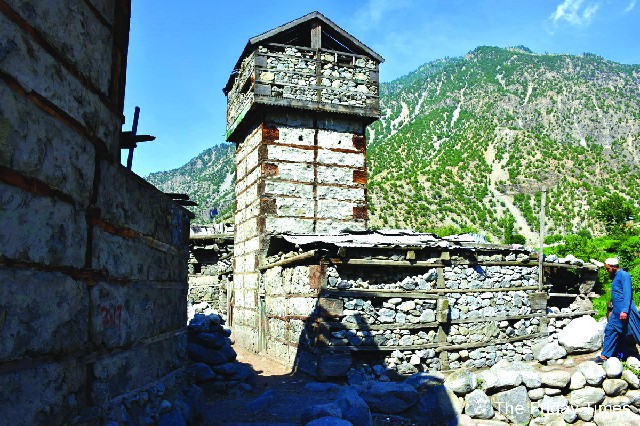
In Harban valley defensive towers are built to keep an eye on a possible ambush by arch enemies. Blood feuds are very common in Indus-Kohistan and Diamer district in Gilgit-Baltistan. The concept of revenge is very much entrenched in Kohistani society.
Harban Nala is a tributary of the Indus River and located in the Upper Kohistan district in Khyber-Pakhtunkhwa province.
Zulfiqar Ali Kalhoro
Harban Nala is a tributary of the Indus River and located in the Upper Kohistan district in Khyber-Pakhtunkhwa (KP) province. It is situated on the left side of the Indus River. A road springs from the Karakoram Highway (KKH) and ends at Kot, which is the oldest and last settlement of the Harban valley. It is quite an adventure to travel on the meandering road that passes through picturesque villages in the valley. Harban Kot is located about 14 km from the Shatial bazaar. It is a fertile valley in the upper Kohistan district. Terraced fields line both sides of the small rivulet. It is noted for its distinctive culture, history and heritage in the entire Indus-Kohistan region. It was formerly part of Yaghestan (the Country of the Free, or the Rebel Region) during the British colonial period. The principal communities in the Harban valley are Shin, Yeshkun and Kamin.
The first things that one notices on entry to the valley are watchtowers or defensive towers which appear popping up against the hilly slopes. On the roadsides and the hilltops are majestic views of watchtowers that herald the power of leading families in a village. These watchtowers are symbols of volatile tribes whose chiefs and notables spent most of their time fighting the enemies. All these watchtowers are constructed to protect their families from the onslaught of enemies. Blood revenge is the norm in a society where one loses honor if they fail to avenge a slight. Both feud narratives dominate the daily discourse in the valley. Battle narratives against the Dogra rule are still celebrated by the old people in the valley.
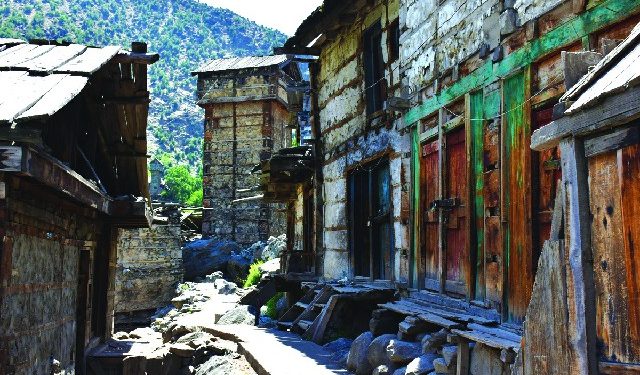
The first principal village that one sees on the entry to Harban valley is Masaring. The beauty of the terraced fields overlooking the rivulet right from Masaring village to Kot attracts visitors. Tower houses overlooking the terraced fields and tucked in the hills look like a wonderland. There are about 14 watchtowers that one can count in the Masaring village. The next picturesque village in Harban is Sigemos. Between Sigemos and Masaring is located Kor village which is also noted for scenic beauty. Darli and Daargah are the two most beautiful villages before one gets to Kot. Darli which is the main settlement of Kamin community has also many tower houses, each of which is also noted for intricate woodwork seen on the main entrances to the houses. In the center of Daargah village is located a small group of hills which is covered with houses. The topmost of one of the hills is dominated by a four-story tower from where one can have a panoramic view of Daargah village. There are many other watchtowers in this Shin dominated settlement.
Likewise, the landscape of Theeng, Babeny and other villages is also dotted with watchtowers. In the past, there used to be the main entrance which was flanked by watchtowers in each of the fortified villages in Harban. Now, these main entrances (Baro dar) do not exist in the fortified villages in Harban valley.
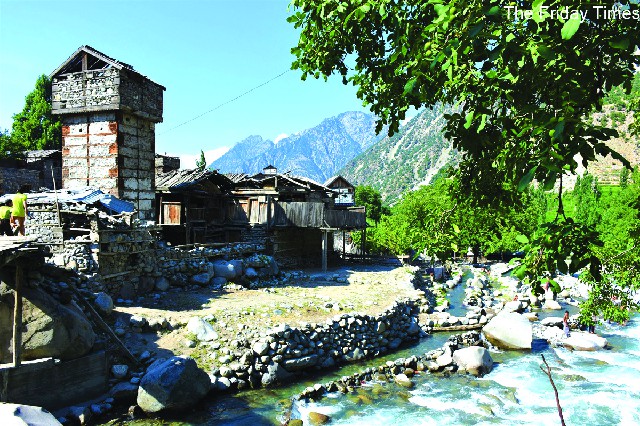
Harban is the only valley in the entire Indus-Kohistan area where one finds a large number of tower houses. The tradition of building tower houses or defensive towers has waned in other valleys. Formerly, defensive towers were seen all along the Silk Road right from the valley of Besham in Shangla to Basaha in Indus Kohistan. The valleys of Palus, Pattan, Dubair, Kandia, Jalkot, Seo, Sazin, Sumar and others were noted for watchtowers. There are still a few villages in these valleys where one finds watchtowers. Apart from Indus-Kohistan, the tradition of building defensive towers still continues in Darel and Tangir in the Diamer district. Although the blood feuds are fewer in the valleys, these towers are actually part of their vernacular architecture.
The majority of the families in both valleys who do not have any blood feud history have still recently constructed watchtowers. This shows that they want to continue and keep their earlier traditions intact.
In Harban valley defensive towers are built to keep an eye on a possible ambush by arch enemies. Blood feuds are very common in Indus-Kohistan and Diamer district in Gilgit-Baltistan. The concept of revenge (Badal) is very much entrenched in Kohistani society. According to Jurgan Wasim Frembgen, honor in Harban is an extremely complex concept. It comprises personal integrity and self-respect, honor within the family, within the caste and the village – all of which Frembgen has discussed in his book The Closed valley, with Fierce Friends in the Pakistani Himalayas.
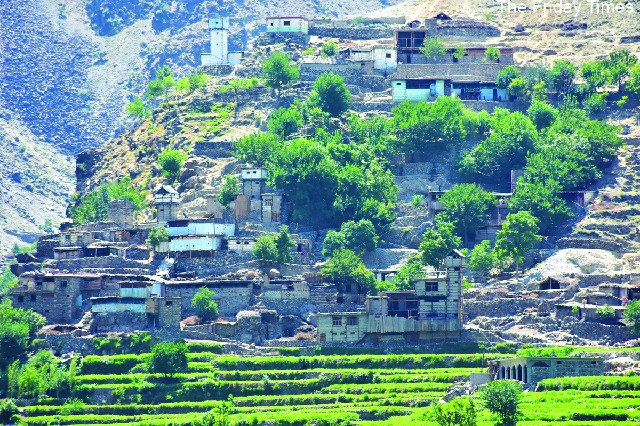
Blood feuds are mostly related to land and women. My anthropological pursuits led me to several valleys in Indus-Kohistan. I visited some of the valleys in Indus Kohistan several times for my research on “The Cultural Construction of Violence” in Indus-Kohistan, Darel and Tangir. For this purpose, I visited the valleys of Pattan Dubair, Kandia Seo, Sazin and Harban. In recent years, both Seo and Sazin have improved their literacy rate and many young Kohistanis are now studying in various universities of Peshawar, Lahore, Islamabad and Karachi. People are migrating to cities and towns for education and employment. However, the process is slow as compared to several other valleys in Indus-Kohistan. Harban’s society is not completely open to visitors.
The whole valley of Harban from Masarang to Kot is dotted with watchtowers. The majority of towers are four-story structures having four rooms. There is a different name for each of the rooms in the local language. For instance, the first room in the watchtower is called Beg, second Gosh, third Darmani Gosh and fourth room Thato. The fourth or uppermost story is used to guard their houses. There are two types of watchtowers, called Gharis or alternatively Shikaris. The first is attached to a house and thus it is called a tower house and the second is a free-standing watchtower which is not attached to another structure. The second is always constructed as the first line of defence against the enemy. Now, there are fewer free-standing watchtowers in Harban’s valleys as compared to those attached to the houses. Due to the local availability of timber, the cost of construction of a Ghari varies from Rs.5-800,000. The cost of construction exceeds Rs.4 million if timber is purchased.
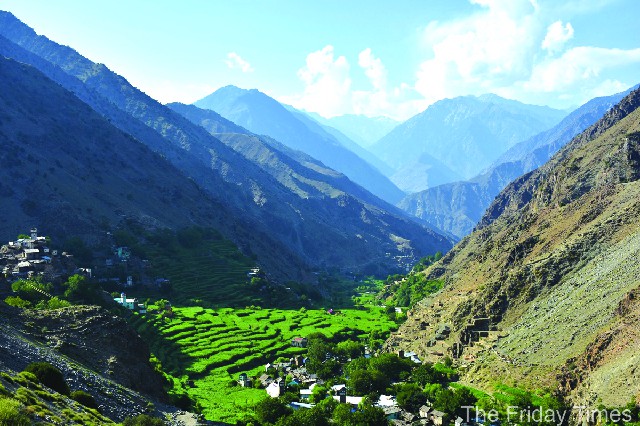
Several watchtowers are seen in Kot village. The earliest watchtower in Kot was built in the last quarter of the nineteenth century by Akram, one of the notables of Kot. This watchtower stands in heart of Kot and is named after him as Akram’s Ghari (watchtower). It is a four-story tower and is noted for beautiful wood carvings. Cator and cribbage techniques were followed to construct the watchtower. This construction strategy employs locally available wood and stone as prime materials for construction. Each of the wooden pieces used in the watchtower of Akram depicts a variety of floral and geometric designs.
There were four wooden mosques in Kot which were noted for intricate woodwork. All the mosques have been rebuilt recently. These are located around the Jirga place in Kot. There are found impressive Jirga benches (kai) and platforms (byak) at this place. These Kai and byaks are ornately carved. The tradition of Kai (benches) and byaks (platforms) was mainly found near mosques and Jirga assembly halls. In almost every village in Indus-Kohistan and even in Diamer district in Gilgit-Baltistan were found wooden benches and platforms which were decorated with a variety of floral and geometric designs. Kais and byaks of Harban Kot are among the most impressive and some of these also have decorative posts.
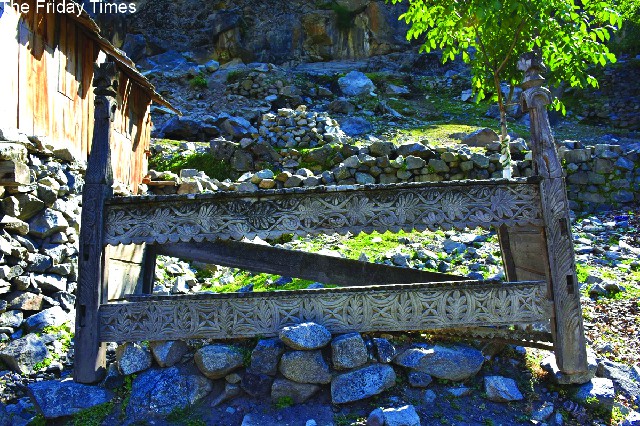
When the mosques of Harban Kot were rebuilt, old wooden pillars and beams were sold in the Shatial Bazar in Indus-Kohistan and Gumari Bazar in Darel valley. I saw some of the decorative pillars which were reused by a person in his house at Dagot village in Manikyala Bala in Darel valley. Apart from the wooden mosques of Harban Kot, there were also some old wooden mosques in other villages in Harban valley. The most imposing wooden mosque can be seen in Theeng village. This mosque is noted for intricate woodwork which is believed to have been built in the first quarter of the twentieth century.
There are also beautiful wooden coffins in Kot. These are located at three places in the village, however, the most decorative wooden coffins are found in the Gashing area of Kot. Wooden coffins are also found in other villages of Harban. Apart from Harban valley, wooden coffins are found almost in every valley in Indus-Kohistan but now the majority of the decorative grave coffins have disappeared. I have visited almost every valley in Indus-Kohistan, Swat-Kohistan and Dir-Kohistan in KP to document decorative wooden coffins. I have also seen the grave wooden coffins of Darel and Tangir valleys in the Diamer district. In fact, I have written several articles on wooden coffins of Darel and Tangir.
Blood feuds were common a few years ago in Harban valley – a phenomenon which has now dwindled but not stopped completely. Like most of the other valleys in Indus-Kohistan, Harban is also more accessible now. The migration has a positive impact on the community in the valley. It is expected that with the opening of the CPEC route in the future, Harban valley will be the most visited tourist destination in the Upper Kohistan district, as it offers the best places for culture enthusiasts and nature lovers.
__________________
 Dr. Zulfqar Ali Kalhoro, an anthropologist, has authored 12 books including ‘Symbols in Stone: The Rock Art of Sindh’, ‘Perspectives on the art and architecture of Sindh’, ‘Memorial Stones: Tharparkar’ and ‘Archaeology, Religion and Art in Sindh’. He may be contacted at: zulfi04@hotmail.com
Dr. Zulfqar Ali Kalhoro, an anthropologist, has authored 12 books including ‘Symbols in Stone: The Rock Art of Sindh’, ‘Perspectives on the art and architecture of Sindh’, ‘Memorial Stones: Tharparkar’ and ‘Archaeology, Religion and Art in Sindh’. He may be contacted at: zulfi04@hotmail.com
Courtesy: The Friday Times Lahore